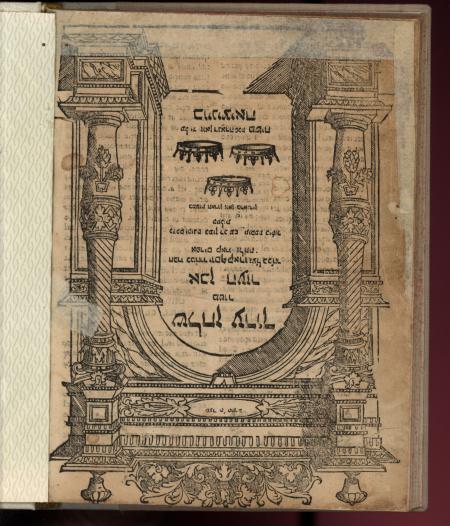Obj. ID: 38880
Jewish printed books Shulchan Aruch, Even ha-Ezer, Venice, 1598

This text was prepared by William Gross:
This book is one part only of a small format, four part edition of the Shulchan Aruch. This section is "Even ha-Ezer".
The Shulchan Aruch (Hebrew: שֻׁלחָן עָרוּך, literally: "Set Table") by R. Yosef Karo is the most widely-consulted and authoritative code of Jewish law. The work was authored in Safed, Israel in 1563 and published in Venice two years later. Together with its commentaries, it is the most widely accepted compilation of Jewish law ever written.
While the halakhic rulings of the Shulchan Aruch generally follow Sephardic law and customs, the gloss of Moses Isserles (the Rema) provides the Ashkenazic customs where they differ from those of the Sepharadim.. These glosses are widely referred to as the mappah (literally: "The Tablecloth") to the Shulchan Aruch's "Set Table". Almost all published editions of the Shulchan Aruch include this gloss, and the term "Shulchan Aruch" has come to denote both Karo's work as well as Isserles', with Karo usually referred to as "the mechaber" ("author") and Isserles as "the Rema".
The Shulchan Aruch (and its forerunner, the Beit Yosef) follow the same structure as Arba'ah Turim by Rabbi Jacob ben Asher. These books were written from the standpoint of Sephardi Minhag, other works entitled Shulchan Aruch or Kitzur Shulcan Aruch cited below are written from the standpoint of Ashkenazi Minhag. There are four sections, each subdivided into many chapters and paragraphs.
1. Orach Chayim - laws of prayer and synagogue, Sabbath, holidays;2. Yoreh De'ah - laws of kashrut; religious conversion; Mourning; Laws pertaining to Israel; Laws of family purity 3. Even Ha'ezer - laws of marriage, divorce and related issues; 4. Choshen Mishpat - laws of finance, financial responsibility, damages (personal and financial), and the rules of the Bet Din, as well as the laws of witnesses
Joseph ben Ephraim Karo (Yosef Caro, 1488 – March 24, 1575), was born in Toledo, Spain in 1488. In 1492, at age the age of four, he was forced to flee Spain with his family and the rest of Spanish Jewry as a result of the Alhambra Decree, and subsequently settled in Portugal. After the expulsion of the Jews from Portugal in 1497, the Ottomans invited the Jews to settle within the Ottoman Empire. Karo went with his parents to Nikopol, Bulgaria, then a city in the Ottoman Empire, and spent the rest of his life in the Ottoman Empire. In Nikopol, he received his first instruction from his father, who was himself an eminent Talmudist. He married, first, Isaac Saba's daughter, and, after her death, the daughter of Hayyim Albalag, both of these men being well-known Talmudists. After the death of his second wife he married the daughter of Zechariah Sechsel (or perhaps Sachsel), a learned and wealthy Talmudist.
Already as a young man, R. Karo gained a reputation as a brilliant Torah scholar. He began by writing an explanation on the Rambam's Mishneh Torah, which he entitled the Kesef Mishnah. Here he cited and explained Rambam's sources.
Between 1520 and 1522 Karo settled at Edirne. He later settled in the city of Safed, c.1535, having en route spent several years in Salonica (1533) and Istanbul.
The printer Giovanni di Gara (active 1564-1610) was known in Venice as the “heir of Bomberg” not only because Bomberg instructed him in Hebrew printing, but also because Di Gara acquired most of Bomberg’s Hebrew types. He was born in Riva del Garda to Christian parents sometime between 1520 and 1530 and moved to Venice with his family as a young boy. He began working at Bomberg’s press as a child. It is believed Di Gara’s first Hebrew books were printed at Bomberg’s own press, since some of them bear the phrase “in the house of Bomberg”. In other early Hebrew books, Di Gara noted when he used Bomberg’s types with the phrase “with the letters of Bomberg”. Over time, this phrase came to mean ‘in the Bomberg style’.
Di Gara worked closely with the press of fellow Venetian Bragadini, as evidenced by the use of his types from 1599 to 1600 and the incorporation of his three-crown printer’s mark (Di Gara’s own printer’s mark was a small single crown). Di Gara employed Jews whenever legally permitted to do so to ensure the accuracy of his Hebrew editions. Books printed under the supervision of Christian typesetters suffered from many errors, whose corrections were costly to the firm.
Di Gara’s press printed close to 300 Hebrew books from approximately 1565 until his death in 1609 (at least one Hebrew book was printed posthumously from his press in 1610). Many of these books bear his iconic title page: a Roman arch whose pillars are topped with Corinthian capitals and wrapped with leaves and fruit. Often a Biblical phrase is included at the top of the arch as in the title page pictured here.


